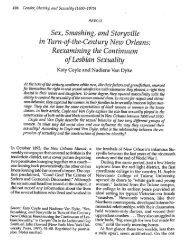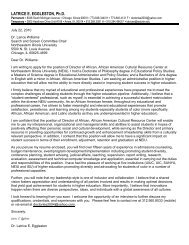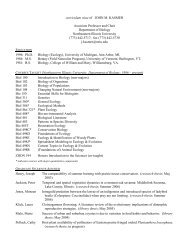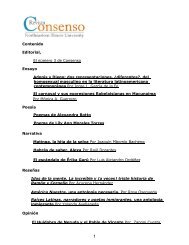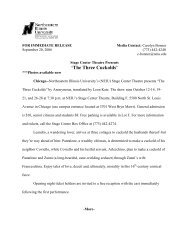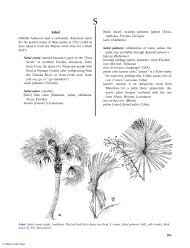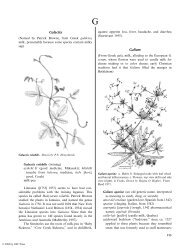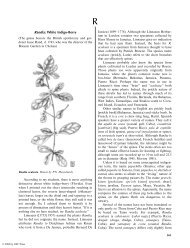Herba Cana - Northeastern Illinois University
Herba Cana - Northeastern Illinois University
Herba Cana - Northeastern Illinois University
Create successful ePaper yourself
Turn your PDF publications into a flip-book with our unique Google optimized e-Paper software.
© 2004 by CRC Press<br />
The Ethnobotany 503<br />
1734 /1735. Linnaeus had adopted Phyllanthus beginning<br />
with Hortus Cliffortianus of 1738.<br />
In Species Plantarum, Linnaeus recorded the six<br />
species that he then knew: P. grandifolia, P. emblica, P.<br />
epiphyllanthus, P. maderaspatensis, P. niruri, and P.<br />
urinaria. Three species were based on specimens from<br />
India (P. emblica, P. maderaspatensis, P. urinaria), and<br />
the others from the Caribbean (P. epiphyllanthus, P.<br />
grandifolia, P. niruri).<br />
It was not until Thomas Walter published his<br />
Flora Caroliniana in 1788 that P. caroliniensis became<br />
known. These small herbs have now been found from<br />
Pennsylvania to Missouri and Kansas south to Brazil,<br />
Bolivia, and Argentina (Fernald 1950, Hocking 1997).<br />
These herbs are like P. niruri and P. urinaria in aspect.<br />
Vásquez and Jácome (1997) found people using P.<br />
caroliniensis to treat bronchitis, bruises, the heart, and<br />
skin problems. It is used as a diuretic in the French<br />
West Indies (Hocking 1997) and as a medicinal in<br />
Belize (Balick et al. 2000). The information available<br />
indicates that these herbs were used in the same ways<br />
as P. niruri and P. urinaria.<br />
However, the story becomes more complicated<br />
once those other two species are considered. Phyllanthus<br />
niruri was described by Linnaeus in 1753. He<br />
thought it was from India and cited both Rheede’s list<br />
of 1678 /1703 containing plants used on the Malabar<br />
Coast of India and John Martyn’s (1699 /1768) list of<br />
plants in cultivation in London in 1728. Although<br />
Linnaeus’s name continues in use, P. niruri has never<br />
been found in India (Webster 1955, 1956, 1970, 2002,<br />
personal communication 2003).<br />
The native range of P. niruri is from southern<br />
Texas, through Mexico to Argentina (Stevens et al.<br />
2001). The plants that are so famous for medicine in<br />
India are actually P. fraternus, not named until studied<br />
by Grady L. Webster (1955). Given the difficulty of<br />
identification of these small herbs, plus the prevalence<br />
of some widespread and weedy species, I suspect that<br />
the small native, and often rare, P. caroliniensis, has<br />
been relegated to a plant that is now neglected.<br />
However, P. caroliniensis contains several bioactive<br />
compounds that would have made it useful. Phytosterols,<br />
quercetin, gallic acid ethyl ester, and geraniin<br />
have been identified in it by Cechinel Filho et al.<br />
(1996a,b). These authors wrote, ‘‘Pharmacological<br />
analysis also revealed that quercetin, gallic acid ethyl<br />
ester and a semi-purified fraction of flavonoids (1 /100<br />
mg kg-1, i.p.) exhibited graded and significant antinociception<br />
against acetic acid-induced abdominal<br />
constriction. The mean ID50 values (mg kg-1) for<br />
these effects were: 18.8, 34.7 and 5.3, respectively. It is<br />
concluded that quercetin, gallic acid ethyl ester and<br />
some as yet unidentified flavonoids might account for<br />
the antinociceptive action reported for the HE [hydro-<br />
alcoholic extract] of P. caroliniensis.’’ Moreover, Santos<br />
et al. (1999) and Narayana et al. (2001) found that<br />
the bioflavonoids in P. caroliniensis were not only<br />
antinociceptive, but also anti-inflammatory.<br />
The plant of choice in most, if not all, of the<br />
Americas is now P. niruri. However, Caribs in Dominica<br />
made a tea of the Old World exotic P. tenellus to<br />
induce abortions, and it kills rabbits and guinea pigs if<br />
they eat it (Hodge and Taylor 1957, Honychurch<br />
1987).<br />
In Cuba, P. niruri is known as yerba de la niña<br />
(little girl’s herb). Elsewhere it is called niruri (Florida),<br />
gale of wind (Florida, English Antilles), peronilla<br />
del pasto (grass pear, Puerto Rico), viernes santo<br />
(Holy Wednesday, Puerto Rico, Colombia), erva<br />
[herva] pombinha (literally little dove herb, but slang<br />
for female genitals, Brazil).<br />
There are two main themes in the common<br />
names*/use to break up kidney stones and use as a<br />
quinine substitute. For the kidney stone theme, it is<br />
called arranca pedras [arrebenta pedras] (stone<br />
breaker, Brazil), malva pedra (probably a lapse for<br />
bad stones, Brazil), and quebra pedra (stone breaker,<br />
Brazil). Names that allude to reducing fever are<br />
feuilles la fièvre (leaves for fever, Haiti), quinina<br />
(quinine, Haiti), quinina créole (Creole quinine, Haiti),<br />
quinina criolla (Creole quinine, Dominican Republic),<br />
quininina [quinine du] pays (country quinine, Haiti),<br />
quininito (little quinine, Haiti), quinino de pobre (poor<br />
person’s quinine, Puerto Rico), and sulfate pays<br />
(country sulfur, Haiti). In Paraguay, the herbs are<br />
paraparai mí (from parapa’rá, Guaraní).<br />
Phyllanthus nirun has names noting seeds below<br />
the leaves. Those include des dos [de dou] (from the<br />
back[s], Haiti), derrière dos (behind the back, Haiti),<br />
and graines sur dos (seeds on [the] back, Haiti).<br />
In Cuba P. niruri is used to treat malarial fever,<br />
diabetes, liver problems, biliousness, and dysentery,<br />
and it is used as a diuretic. In Hispaniola, these bitter<br />
plants are used to treat malaria (Liogier 1978). In<br />
Brazil, the herbs are used against urinary disorders,<br />
diabetes, jaundice, and malaria (Mors et al. 2000). The<br />
fruit juice is considered antidiabetic.<br />
Phyllanthus contain flavonoids, lignans, and glycosides<br />
(Mors et al. 2000). Given the confusion about the<br />
taxonomy, the identity of the species reported as P.<br />
niruri is dubious, but the genus is nonetheless chemically<br />
bioactive. Experiments show significant increase<br />
in diuresis and sodium and creatine excretion (Mors et<br />
al. 2000, Barros et al. 2003). In humans, persistent<br />
ingestion of tea from the roots expels kidney stones.<br />
Phyllanthus extracts show lipid-lowering activity<br />
(Khanna et al. 2002). There are also indications of<br />
antimalarial activity (Tona et al. 2001) and inhibition<br />
of HIV (Qian-Cutrone et al. 1996).





